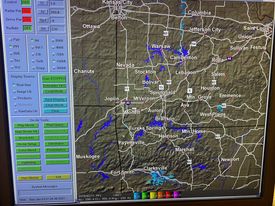Nope that's not an ankle monitor....
As a broadcast meteorologist, I use some pretty cool tech. Whether it be equipment I use as a meteorologist or gear I carry on weather reporting days. Here is a behind the scenes look at some of this tech. Don't forget to comment below or shoot me an email with your thoughts.
IFB and MIC - Not an ankle monitor
I’ve lost track of how many times I’ve gotten messages from viewers asking “What’s on your leg, are you ok?!” The assumptions range from thinking I’m under house arrest or I’m injured (the former most often meant as a joke).
IFB is short for Interruptible Foldback. The intercom system allows me to hear the directors and producers in the control room. With my wireless microphone, I’m able to chat with them and can be heard over the air by viewers.
A hot MIC means the microphone is turned on, and either those in the control room can hear me, or I’m being broadcasted on the air. A cold MIC means it’s turned off and no one can hear me.
What’s the green screen all about?
Aside from weather models and radar, the green screen is one of the most essential tools meteorologists use. I dove into how the green screen works in a previous blog post, which you can check out here: Q & A - Jan. 10th through 16th
The biggest question you may have is, "how am I able to tell where things are on the green screen?" The map is not displayed behind me, so when I point I am LITERALLY pointing at a blank wall. However, monitors on either side and in front of the green screen enable me to see myself in front of weather maps.
Knowing where to point comes with practice. I’ll never forget my first time on the green screen, about 6 years ago now, looking like a flappy bird while waving my arms trying to point at the correct city or county. Now, standing at the wall and pointing has become second nature.
There have been times where the side monitors have stopped working during a show and I can’t see myself or the maps through the side monitors. Thank goodness for muscle memory during these scenarios.
We have our own radar
Radar stands for RAdio Detection And Ranging. The radar sends out electromagnetic waves in pulses and the return waves are reflected. Sending and receiving these waves gives meteorologists a picture of the atmosphere. We’re able to determine precipitation type, particle size, and see storms moving in.
At KY3, we have a personal radar. The radar transmits the waves and we can view the return signals through a monitor pictured below. We can control these radar scans. For example, altering the radar's direction between two points allows us to scan a single storm. We can also alter the range, sending scans as far out as 300 miles or as near as 20 miles. Shortening the signal range gives us a higher resolution.

The National Weather Service has a network of 159 radars across the country. Utilizing these radars, storms are tracked before they move into the Ozarks by looking at radars in Kansas, Oklahoma, and Arkansas.
You can view radar imagery through our weather apps, or with the online interactive tool below:
* * * * * * * * * * * * * *
The technology I chatted about above is only scratching the surface of meteorological and broadcaster resources.
For the IFB, new technology is coming out where they are completely wireless. The earpiece for the IFB fits like an AirPod.
The green screen is also getting an upgrade. For example, our sister TV station in St Louis, KSDK, does not use a green screen. Instead, they present in front of a weather wall composed of nine monitors. The Weather Channel is turning to virtual or augmented reality for their segments. While the green screen is still the most common method for displaying weather maps, eventually it will become outdated.
I haven’t even gone into the satellite imagery which allows us to view the atmosphere from space or weather balloons that give a vertical image of the atmosphere. Not to mention personal weather stations that give an idea of microscale weather factors. You will just have to check back for future posts on these topics.

1 Comment Add a Comment?
Mark Krause
Posted on April 30, 2023, 4:43 p.m.
Leah, great explanation, much appreciated!